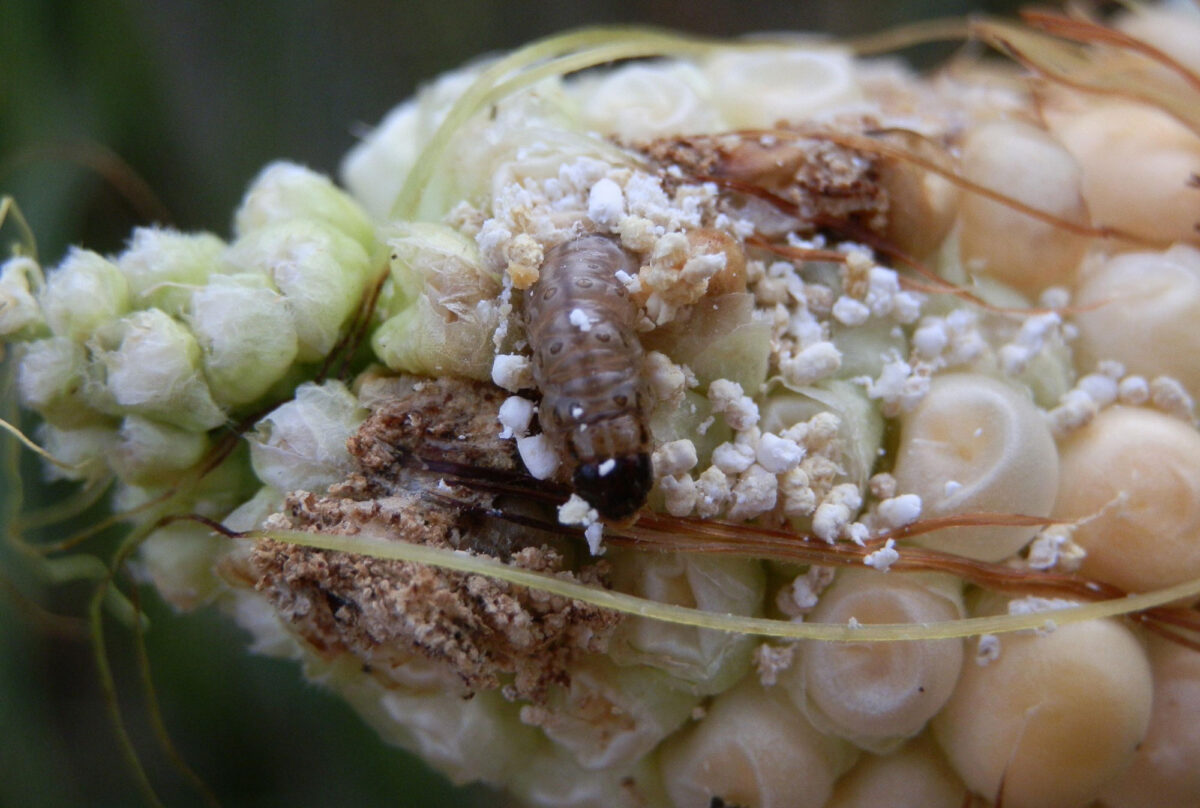Page snapshot: Introduction to crop improvement, including plant breeding and genetic engineering.
Topics covered on this page: Introduction; Plant breeding; Inbreeding; Outcrossing; Hybrids; Genetic engineering and GMOs; Examples of genetically modified crops; Bt crops (pest-resistant crops); Herbicide-resistant crops; Resources.
Credits: Funded by the National Science Foundation. Any opinions, findings, and conclusions or recommendations expressed in this material are those of the author(s) and do not necessarily reflect the views of the National Science Foundation. This page includes content from the Teacher-Friendly Guide to the Evolution Maize (T. M. Fulton, C. S. Buckler, and R. A. Kissel, 2011). Additional content and revisions by Elizabeth J. Hermsen (2023).
Updates: Page last updated March 12, 2023.
Image above: European corn borer (Ostrinia nubilalis) larva feeding on an ear of maize (Zea mays). The development of genetically modified Bt maize has helped protect the maize crop from this pest. Photo by Mariusz Sobieski (Image Number 5492298, InsectImages.org, Creative Commons Attribution-NonCommercial 3.0 United States license, image cropped and resized).
Introduction
Crop improvement is the modification of crops using traditional or laboratory techniques in order in order to create crops with desirable traits. Crop improvement may target the structures of the plants themselves to produce larger or stronger plants or higher yields. Crop improvement can also target many other traits, such as nutritional value, heat and drought tolerance, pathogen and pest resistance, and much more. Crop improvement falls into two broad categories: plant breeding and genetic engineering.
Plant breeding is the purposeful selection, growth, and pollination of particular plants. This differs from natural selection in that, in nature, plants that do better in a particular environment will set seed and pass on the genes that made them successful in that environment. Plant breeders, on the other hand, select plants that have qualities that are desired by humans: bigger fruit, higher yield, particular flavors. Early farmers did this simply by saving seed from those plants that had good characteristics. This type of intentional human-mediated selection is called artificial selection.
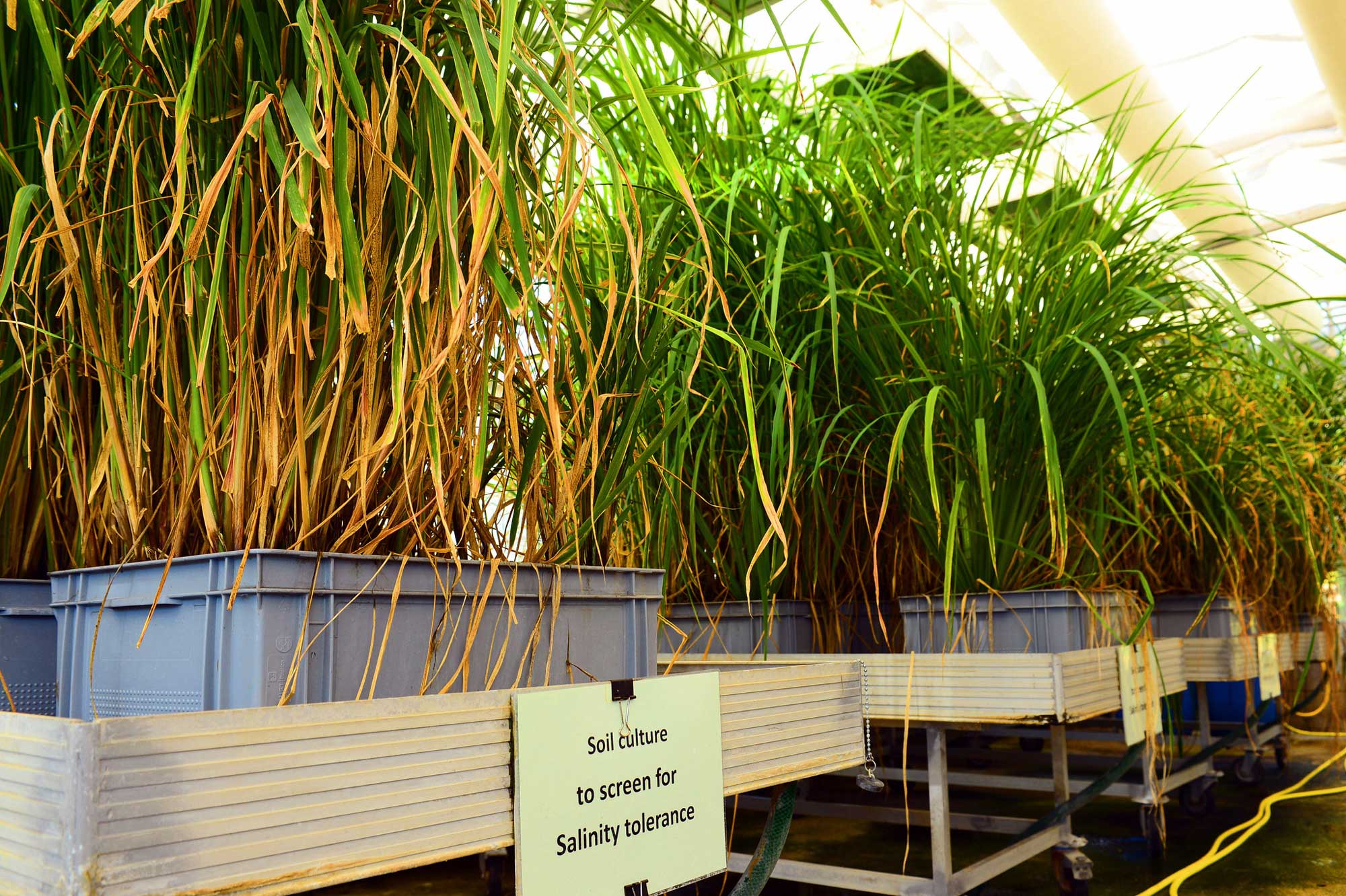
Original caption: "Plant Breeding at the Agency laboratory, Seibersdorf. 2 August 2012." Photo by Dean Calma/IAEA (IAEA Imagebank on flickr, Creative Commons Attribution 2.0 Generic license, image resized).
Genetic engineering is the process of altering the DNA of an organism in a lab. Often, this means inserting DNA from one organism into another by artificial means to create a transgenic organism. Transgenic organisms are commonly called GMOs (genetically modified organisms).
While conventional plant breeding can often accomplish the same result as genetic engineering, genetic engineering is sometimes a more exact method to modify plants and can be much quicker. Genetic engineering may also work where conventional breeding cannot, for example by inserting genes from an unrelated plant or other organism. Notably, genetic engineering and plant breeding are not mutually exclusive; crop plants have been improved using both techniques.
One of the biggest problems faced in crop improvement comes, paradoxically, from its success. Improved crops with desirable traits may be widely adopted, leading to a lack of genetic diversity within cultivated crops. Lack of genetic diversity and its consequences are well-documented in some traditionally bred crops, although GMOs can also suffer the same problems.
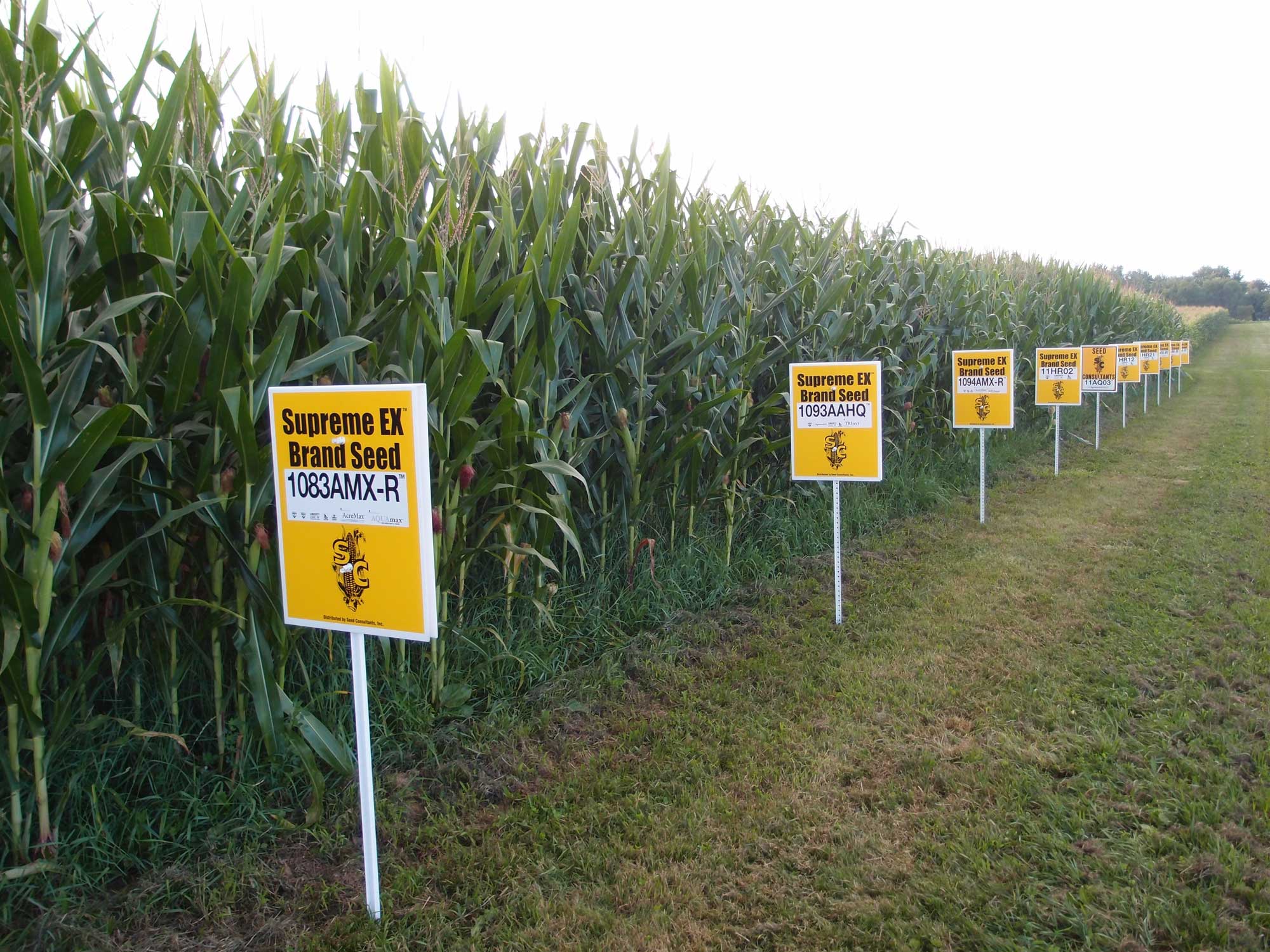
Hybrid maize that has also been genetically engineered, Ohio, 2013. Photo by leyink (flickr, Creative Commons Attribution 2.0 Generic license, image resized).
Plant breeding
Plant breeders manually cross-pollinate plants that have desirable characteristics, meaning that they take pollen from one plant and manually place it on the stigma of another. They then harvest the resulting seed, grow and select new individuals that have desirable traits from both parents combined, and perhaps go through the process of cross pollination again. This process can be continued over generations of plants until the plant breeder feels the resulting plants are ready to be sold as a new variety. Plant breeding, and therefore crop improvement, depends on genetic variation. Cross-pollinating plants that are too similar genetically cannot result in continued improvement.
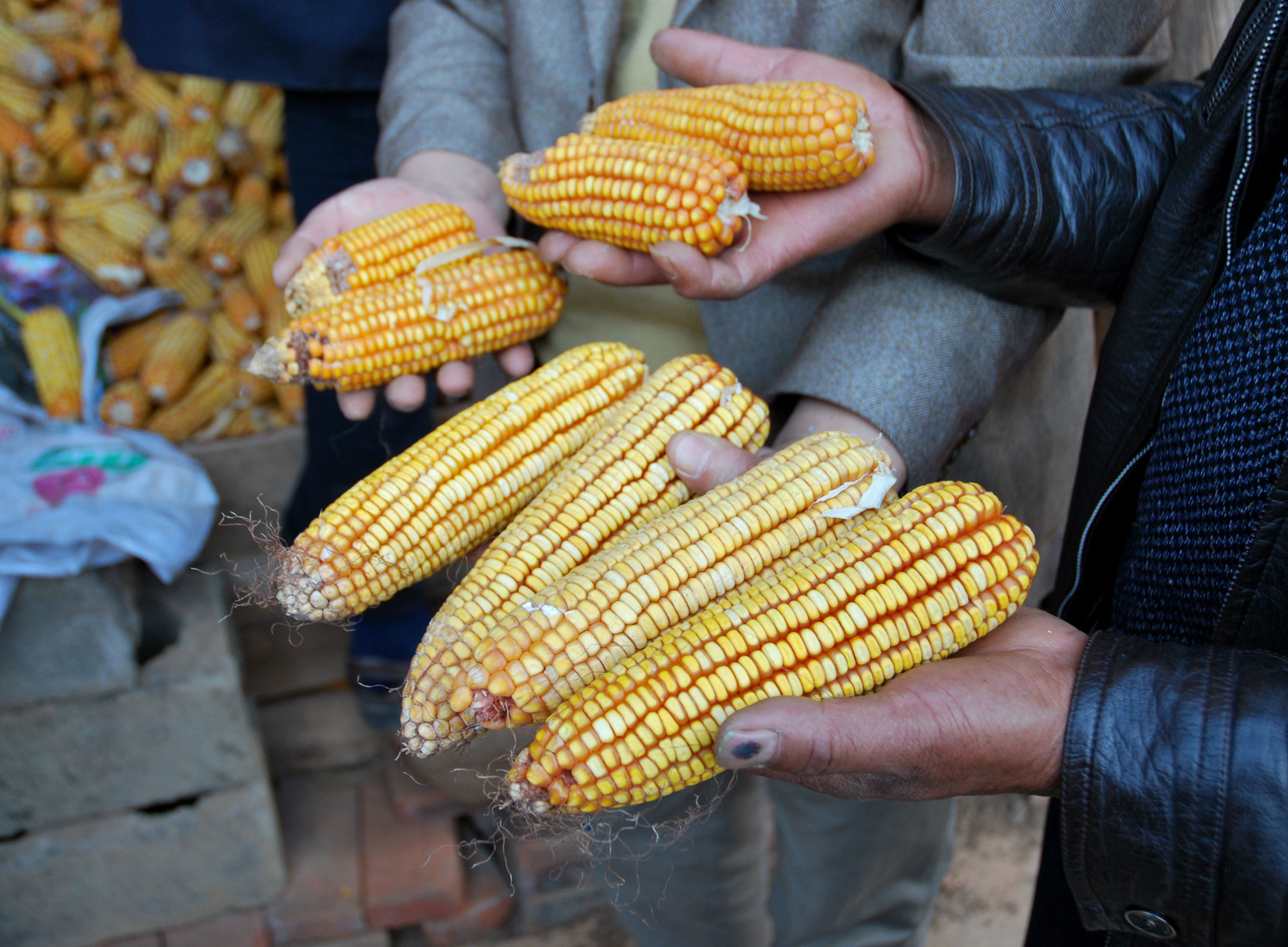
Traditional maize (small ears, background) compared to high-yielding, drought-tolerant hybrid maize (large ears, foreground), both grown under stress conditions in China. Photo by Michelle DeFreese/CIMMYT (flickr, Creative Commons Attribution-NonCommercial-ShareAlike 2.0 Generic license, image cropped and resized).
Inbreeding
Inbreeding occurs when pollen from one plant lands on (or is transferred to) the stigma of a closely related and, thus, genetically similar plant and successful fertilization occurs. For example, in domesticated plants, inbreeding may occur between two plants in the same cultivar. Inbreeding also occurs in self-pollinating plants. Self-pollinating means that the pollen produced by a plant lands on the stigma of that same plant. In naturally self-pollinating plants, self-pollination often occurs in a single flower (meaning that pollen from an anther in a flower lands on the stigma of that same flower). Some domesticated grasses grown for grain, like barley (Hordeum vulgare), rice (Oryza sativa), sorghum (Sorghum bicolor), and wheat (Triticum spp.) are typically self-pollinating.
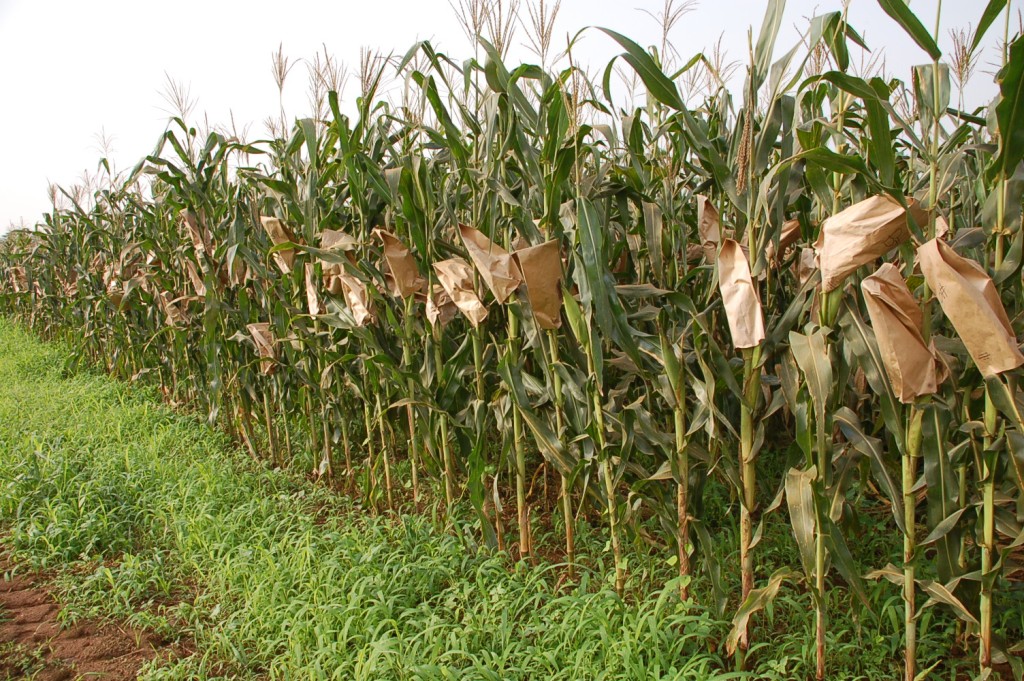
Experimental plot of inbred maize, Ibadan, Nigeria. Maize is wind-pollinated, so paper bags have been placed over the ears to prevent cross-pollination. Photo by International Institute of Tropical Agriculture (flickr, Creative Commons Attribution-NonCommercial-ShareAlike 2.0 Generic license).
Inbreeding has some advantages. Inbreeding creates plant populations that are relatively homogenous, or genetically and phenotypically (physically) similar. Consumers tend to prefer uniformity – think of the rows of perfectly round, red apples we see in the supermarket. In domesticated plants, inbreeding can thus be desirable because inbred plants have predictable traits.
Unfortunately, the process of inbreeding during domestication and crop improvement tends to decrease the genetic diversity of crop species, due in part to the genetic bottleneck created when only a few plants are selected and propagated. In nature, this is not a healthy situation. If anything unusual happens, such as a disease or an adverse environmental condition (for example, a drought), there might not be any plants in the population that carry genes for responding to this new threat. In some plants, like maize, inbreeding can also cause a loss of vigor over multiple generations, a problem called inbreeding depression.
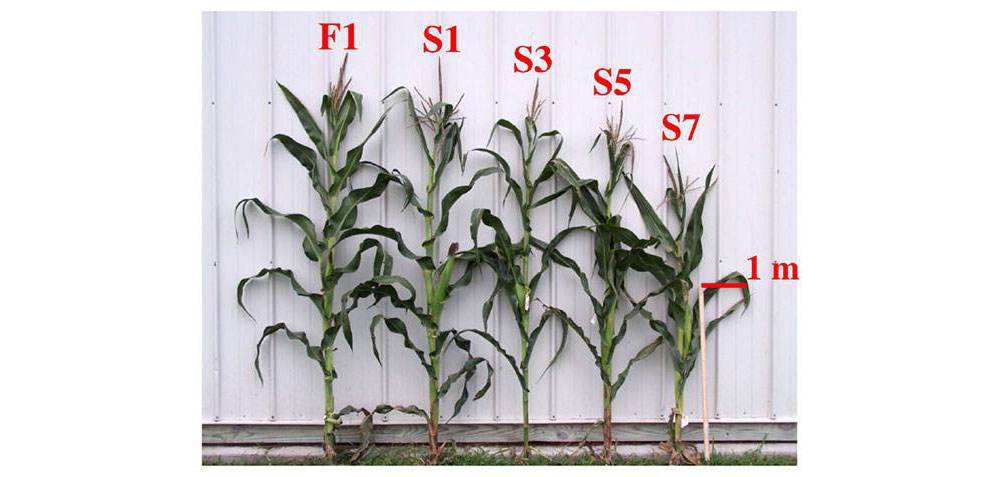
Inbreeding depression in maize (Zea mays). This image shows a hybrid plant (F1, or cross between two homozygous inbred lines) and its descendants over seven generations of inbreeding. S1 = first self-fertilized generation, S3 = third self-fertilized generation, S5 = fifth self-fertilized generation, S7 = seventh self-fertilized generation. The meter stick on the left indicates plant height. Source: Modified from figure 1 in Yao et al. (2020) Frontiers in Genetics 11: 564928 (Creative Commons Attribution 4.0 International license).
Outcrossing (outbreeding)
Outcrossing or outbreeding is a type of cross pollination that occurs when pollen from one plant lands on (or is transferred to) the stigma of a plant that is genetically different. Outcrossing promotes genetic diversity, which is important because it helps maintain the health of a population. Maintaining genetic diversity means that more alleles may be present in a population, thus allowing at least some individuals to resist diseases, pests, and other stresses. Maintaining diversity also gives a population a buffer against change, by maintaining variability that provides the flexibility to adapt. In extreme situations (for example, drought and disease epidemics), genetic diversity could even mean the survival of the population.
Many plants naturally rely on cross pollination for pollination and fertilization. In some cases, plants have even evolved traits that promote or enforce cross pollination, increasing the chances of outcrossing. For example, flower structure, unisexual flowers (meaning flowers that produce only pollen or ovules, not both), and differences in timing of maturation of pollen and ovules in the same flower help to increase the chances that cross pollination will occur. Some plants are self incompatible. These plants rely on chemical signals between pollen grains and stigmas to prevent inbreeding. Among major grass grain crops, maize and rye (Secale cereale) are cross pollinated. Maize has unisexual flowers, whereas rye is self incompatible.
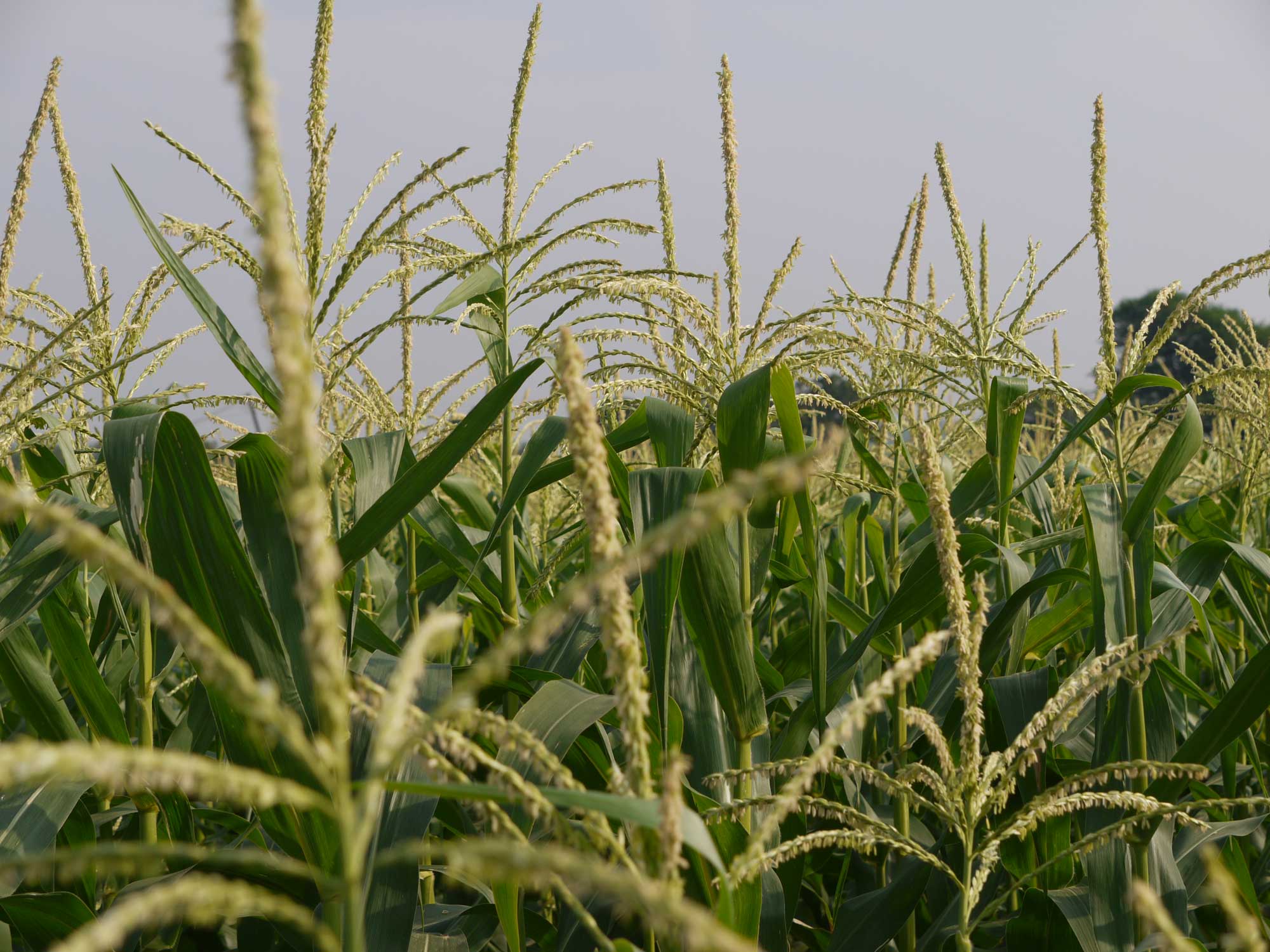
The male (pollen-producing) flowers of maize (Zea mays) are in branching units called tassels that occur at the tips of the stalks. Photo by Dinesh Valke (flickr, Creative Commons Attribution-ShareAlike 2.0 Generic license, image resized).
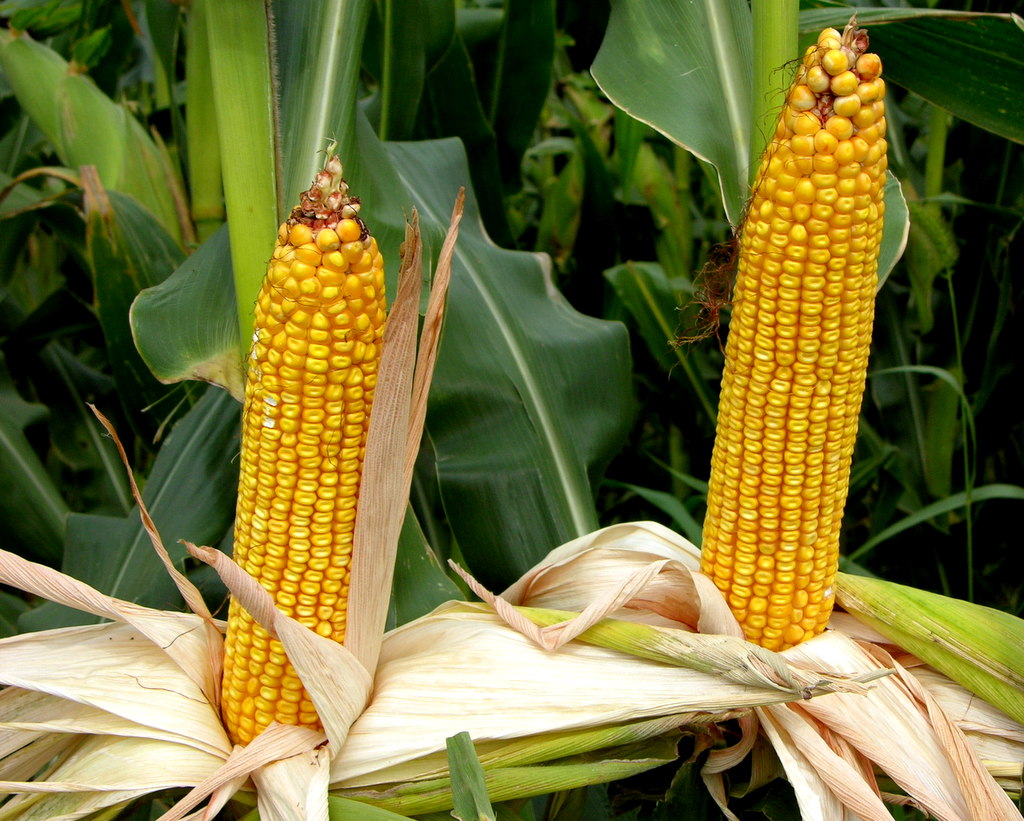
The female (ovule and seed-producing) flowers of maize (Zea mays) are in structures called ears that occur on short branches on the sides of the main maize stalks. The female flowers mature in the kernels on the maize ears after pollination and fertilization. "Corn ears," photo by Phil Warren (flickr, Creative Commons Attribution 2.0 Generic license).
Hybrids
A hybrid is the offspring of two different varieties, breeds, or species of plants. In the context of plant breeding and crop variety development, a hybrid is the heterozygous offspring produced by cross-breeding two homozygous (inbred) individuals. A hybrid has two different alleles (variants) for most genes, which can result in heterosis or hybrid vigor.
Heterosis is a phenomenon where a hybrid organism has greater vigor (often better health and larger size) than its parents; it is the opposite of inbreeding depression. In maize, for example, the hybrid offspring of two distantly related inbred plants will usually be taller and have larger ears (cobs) than either of its parents. Although the phenomenon of heterosis was first described over a century ago and has been exploited in crop breeding ever since, scientists still do not fully understand why it happens. Currently, they believe that heterosis is caused mainly by healthy alleles across numerous genes from each parent compensating for dysfunctional alleles at those genes in the other parent.
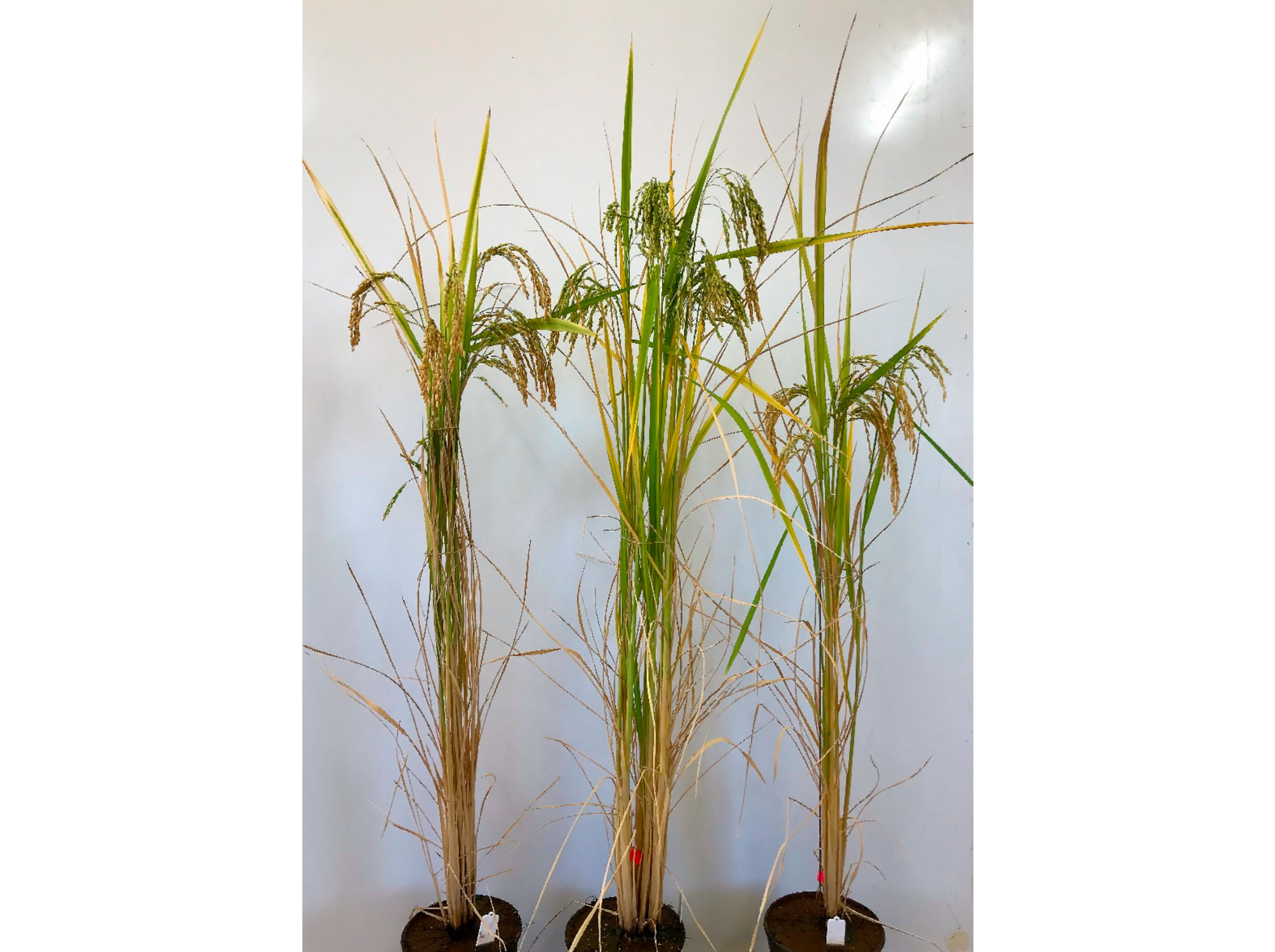
Heterosis in rice (Oryza sativa). A hybrid is shown in the middle, with its parent cultivars on the left (O. sativa 'Reiziq') and right (O. sativa 'Doongara'). Source: Modified from figure 5 in Zhang et al. (2022) Agronomy 12(7): 1559 (Creative Commons Attribution 4.0 International license).
In cultivated plants, each crop of hybrid plants must be grown from seed produced by crossing the same inbred parental lines in order to maintain consistancy and vigor. If hybrids are crossed with one another, their offspring will have variable traits. Thus, modern hybrids suffer from the same lack of diversity as inbred varieties of plants, which can have serious consequences. For example, in the late 1960s to early 1970s, a devastating outbreak of Southern Corn Leaf Blight (SCLB), a disease caused by a fungus (Bipolaris maydis), spread in maize-producing regions of Canada and the U.S. At that time, more than 85% of the U.S. hybrid maize crop was made up of plants created using Texas male sterile maize. Texas male sterile maize plants and their hybrid offspring are especially susceptible to SCLB. About 15% of the maize crop was ruined, for a loss of about $1,000,000,000 (not adjusted for inflation).
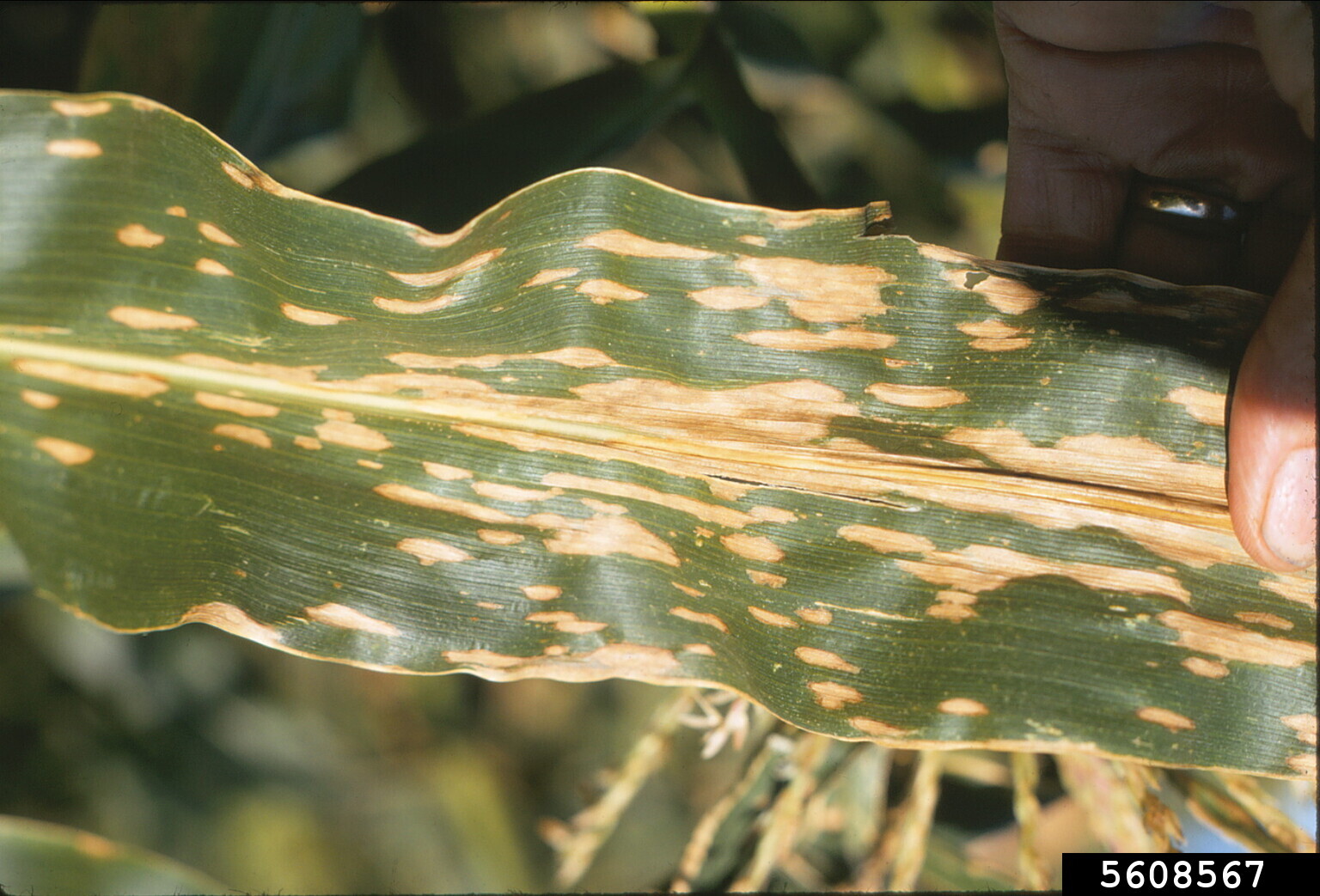
Southern Corn Leaf Blight (Bipolaris maydis) on a maize leaf. Photo by Craig Grau (Image 5608567, Bugwood.org, Creative Commons Attribution-Noncommercial 3.0 United States license).
Genetic engineering and GMOs
A plant can be genetically modified in a few ways. One is by using a "gene gun" to blast a foreign piece of DNA into its genome. Alternatively, the bacterium that causes crown gall disease, Agrobacterium tumefaciens, can be used to insert DNA into a plant's genome. Agrobacterium tumefaciens is a naturally occurring bacterium found in soil that has the ability to transfer some of its own DNA into the DNA of plants that it has infected. A newer technology called CRISPR can be used to edit a plant's DNA without inserting DNA from other organisms. Since plants modified using gene editing are genetically engineered but not transgenic, many do not consider them to be GMOs.
Genetic engineering is controversial. Some people feel it is unnatural to use biotechnology to create plants that most likely would not occur in nature. They have questions about the safety of these new plants. Some of these questions are as relevant to conventional plant breeding, which also results in new crop varieties, as they are to GMOs. Studies are ongoing worldwide to address issues related to GMOs.
Some countries mandate the labeling of GMOs or food containing GMOs. As of 2022, food containing ingredients from transgenic plants must be labeled as "Bioengineered" or similar in the United States, although there are exceptions. Some food is labeled as non-GMO. In the U.S., non-GMO foods do not have to be labeled, so such labels are primarily for consumer choice and marketing purposes.

The March Against Monsanto, Vancouver, Canada, 2013. Photo 032A3231 by Rosalee Yagihara (flickr, Creative Commons Attribution 2.0 Generic license, image cropped and resized).
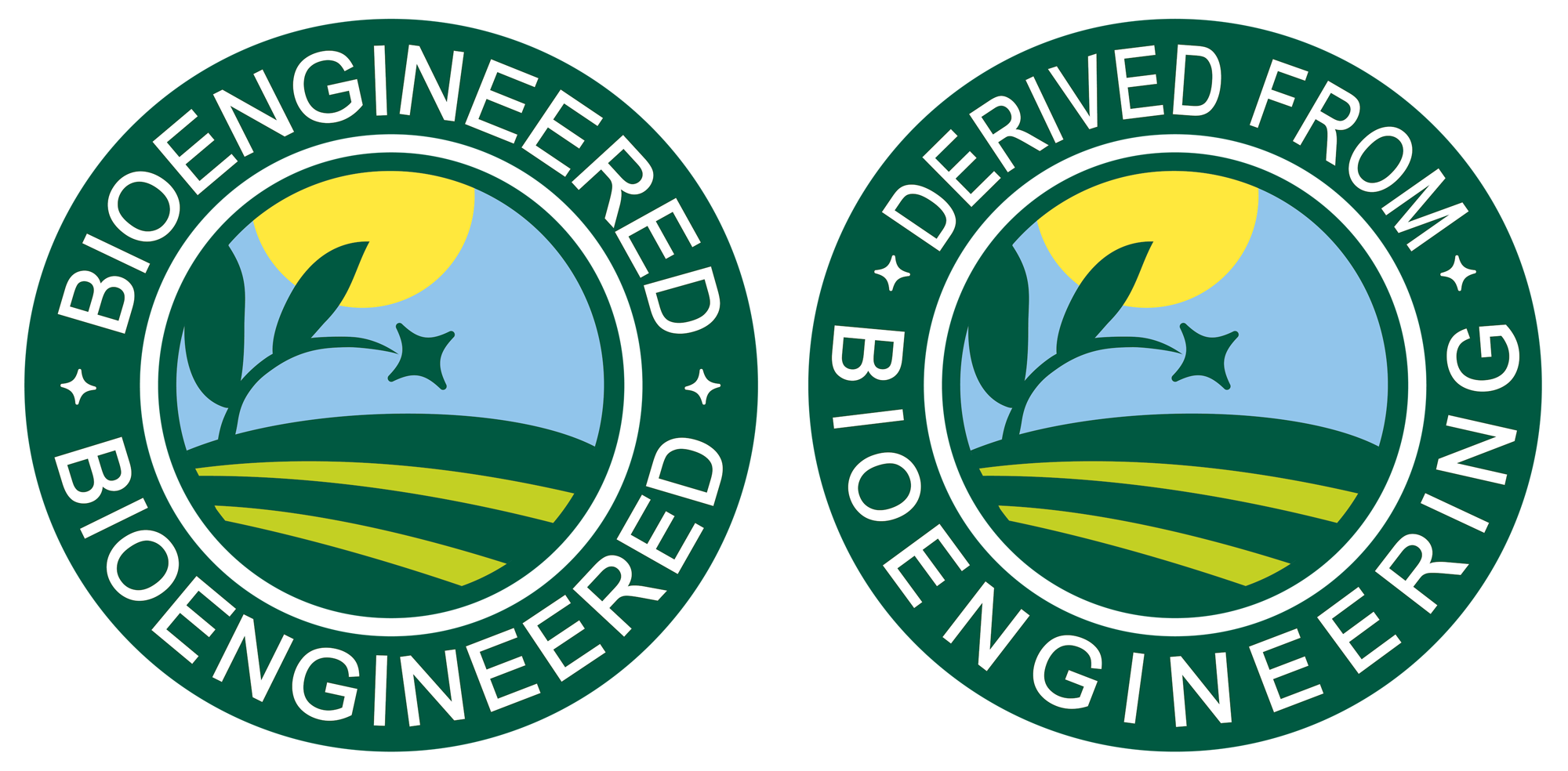
USDA labels for bioengineered food. Source: USDA Agricultural Marketing Service.
Examples of GMOs
In the U.S. and worldwide, the most commonly grown genetically modified (GM) crops are maize, soybean (Glycine max, a legume), and cotton (Gossypium spp.); in the U.S., canola (Brassica napus) and sugar beets (Beta vulgaris) are also commonly genetically modified. In fact, over 90% of the U.S. acreage devoted to these five crops is planted with GM crops. These crops are typically genetically modified to have one or both of two traits: resistance to moth pests and/or herbicide resistance.
GMOs have also been created to resist plant disease. One notable example is papaya (Carica papaya, sold as Rainbow or Sunup) that has genetically engineered to resist papaya ringspot virus. Some other GM crops that have been developed include low-lignin alfalfa (Medicago sativa, sold as HarvXtra), non-browning apples (Malus domestica, sold as Arctic), and pink-fleshed pineapple (Anana comosus, sold as Pinkglow). GM crops with improved nutritional profiles are also being explored, as are plants with greater drought tolerance, among other characteristics.
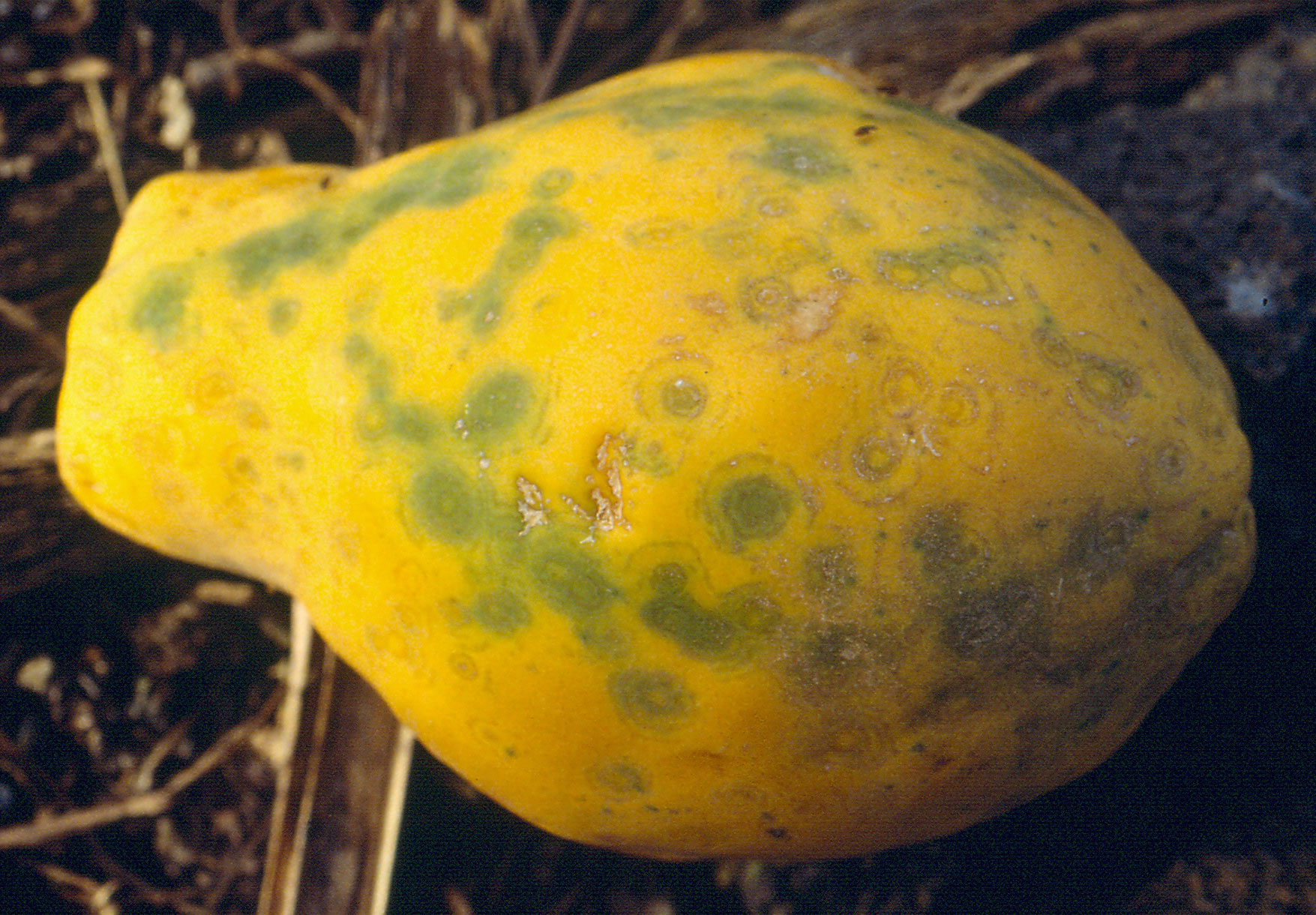
Papaya afflicted with ringspot virus. Photo by Scot Nelson (flickr, CC0 1.0 Universal/public domain dedication).
Bt crops (pest-resistant crops)
Genetic engineering has been very useful is in adding pest resistance to crops. The bacterium Bacillus thuringiensis produces toxins that are deadly to the caterpillars of butterflies and moths, such as corn borers (Papaipema spp.) and corn earworms (Helicoverpa spp., also known as cotton bollworms or tobacco budworms). These toxins have been widely used in insecticides since the 1920s and are considered to be safer and more environmentally friendly than many other insecticides.
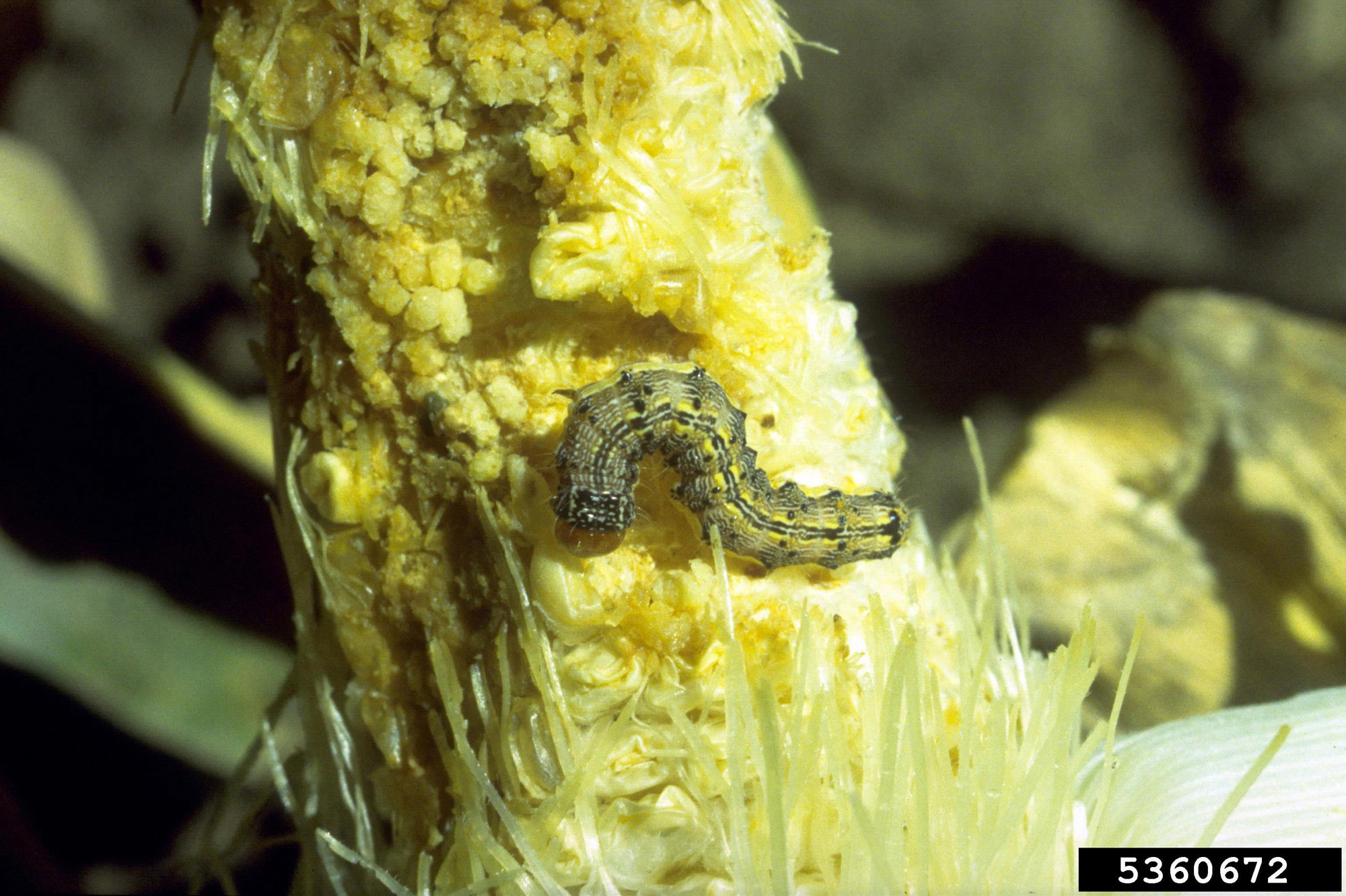
Corn earworm (Helicoverpa zea) feeding on an ear of maize. Photo by Eugene E. Nelson (Image number 5360672, insectimages.org, Creative Commons Attribution 3.0 United States license, image resized).
Since the 1980s, genetic engineering has been used to insert the genes that produces Bt toxins into crops, including maize and cotton; such plants are called Bt plants. Bt plants are now widely grown. This application of genetic engineering has been useful to farmers in preventing corn borers and other moth pests from devastating crops. It has also greatly reduced the use of pesticides on maize and cotton throughout the world. The number of pesticide sprayings in the Mississippi Delta region dropped by half just within the first year that Bt cotton was widely grown. In the U.S., the volume of pesticide used on maize was decreased by 12% due to the use of Bt maize.
Some moth pests have developed resistance to the toxins in Bt crops in some areas of the world; for example, pink bollworm (Pectinophora gossypiella, a pest of cotton) has developed resistance to Bt cotton in India. Pest populations can develop tolerance for Bt toxins if pest insects that are not resistant Bt toxins are killed off, whereas individuals with natural resistance to Bt toxins are allowed to survive and breed, thus making up a greater and greater share of the insect pest population over time. Strategies such as spraying pesticides in addition to using Bt crops, creating refuges (growing some non-Bt plants along with Bt plants so that non-resistant insects can survive and reproduce), and crop rotation can help to keep the pest insect population from becoming fully resistant to Bt toxins.
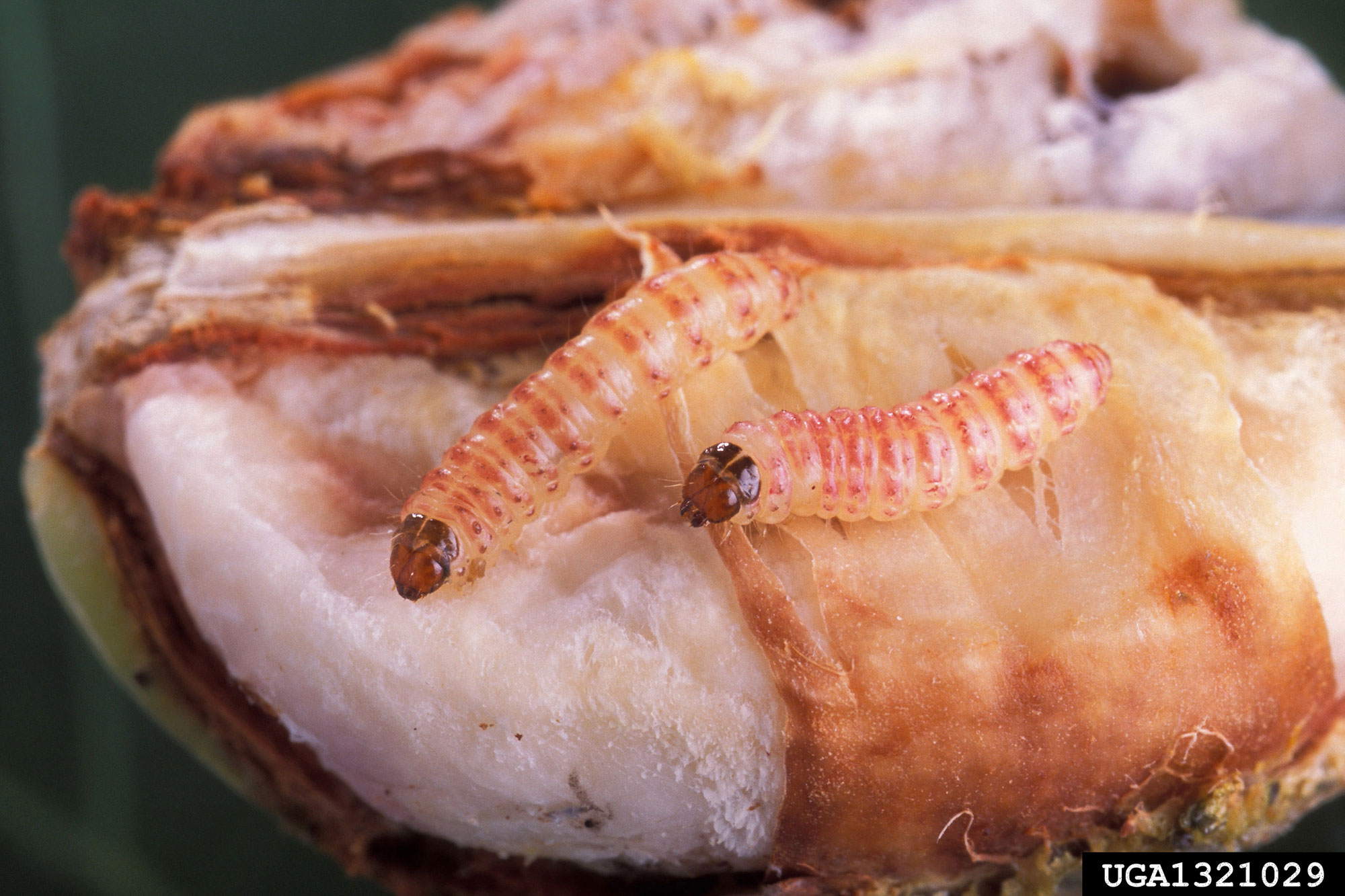
Pink bollworm (Pectinophora gossypiella). Photo by Peggy Greb (Image 1321029, InsectImages.org, Creative Commons Attribution-Noncommercial 3.0 United States license, image resized).
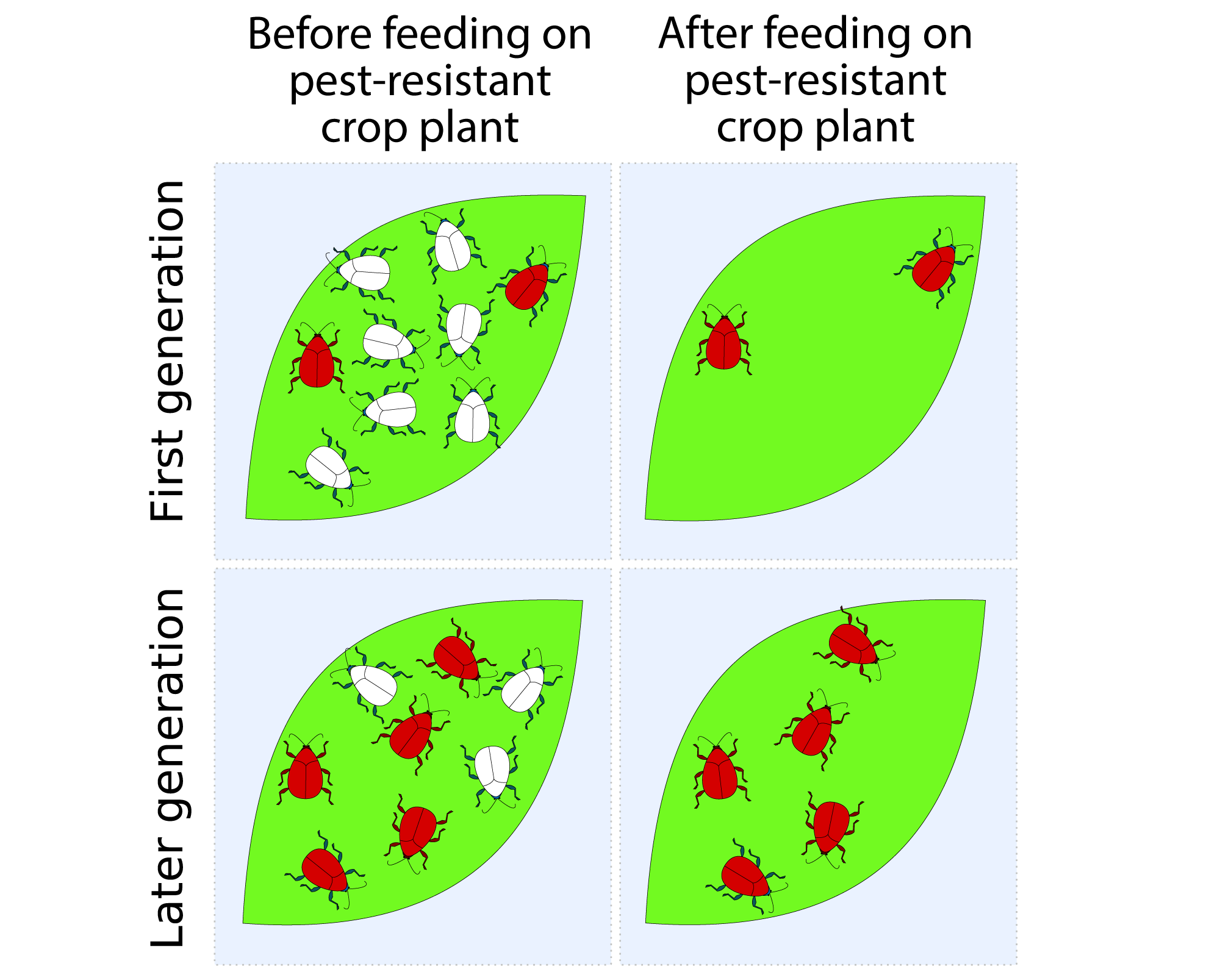
Diagram showing how an insect population can develop resistance to a pest-resistant crop plant over time if steps are not taken to manage the problem. In this image, the red insects are resistant to the toxins in the plant, whereas the white insects are not. In the first generation, relatively few insects are resistant to the toxins. In later generations, however, resistant insects make up a great proportion of the population. Modified from a diagram by Self (Wikimedia Commons, Creative Commons Attribution-ShareAlike 3.0 Unported license).
Herbicide-resistant crops
Herbicide-resistant crops are modified to be able withstand spraying by herbicides like glyphosate and dicamba without being damaged. The genes for herbicide resistance come from bacteria. These herbicides are used to kill broadleaved agricultural weeds that infest fields, like Palmer pigweed (Amaranthus palmeri), tall waterhemp (Amaranthus rudis), horseweed (Erigeron canadensis), and ragweeds (Ambrosia spp.). When sprayed, the herbicide-resistant crops remain healthy while the weeds are killed, improving crop yields.
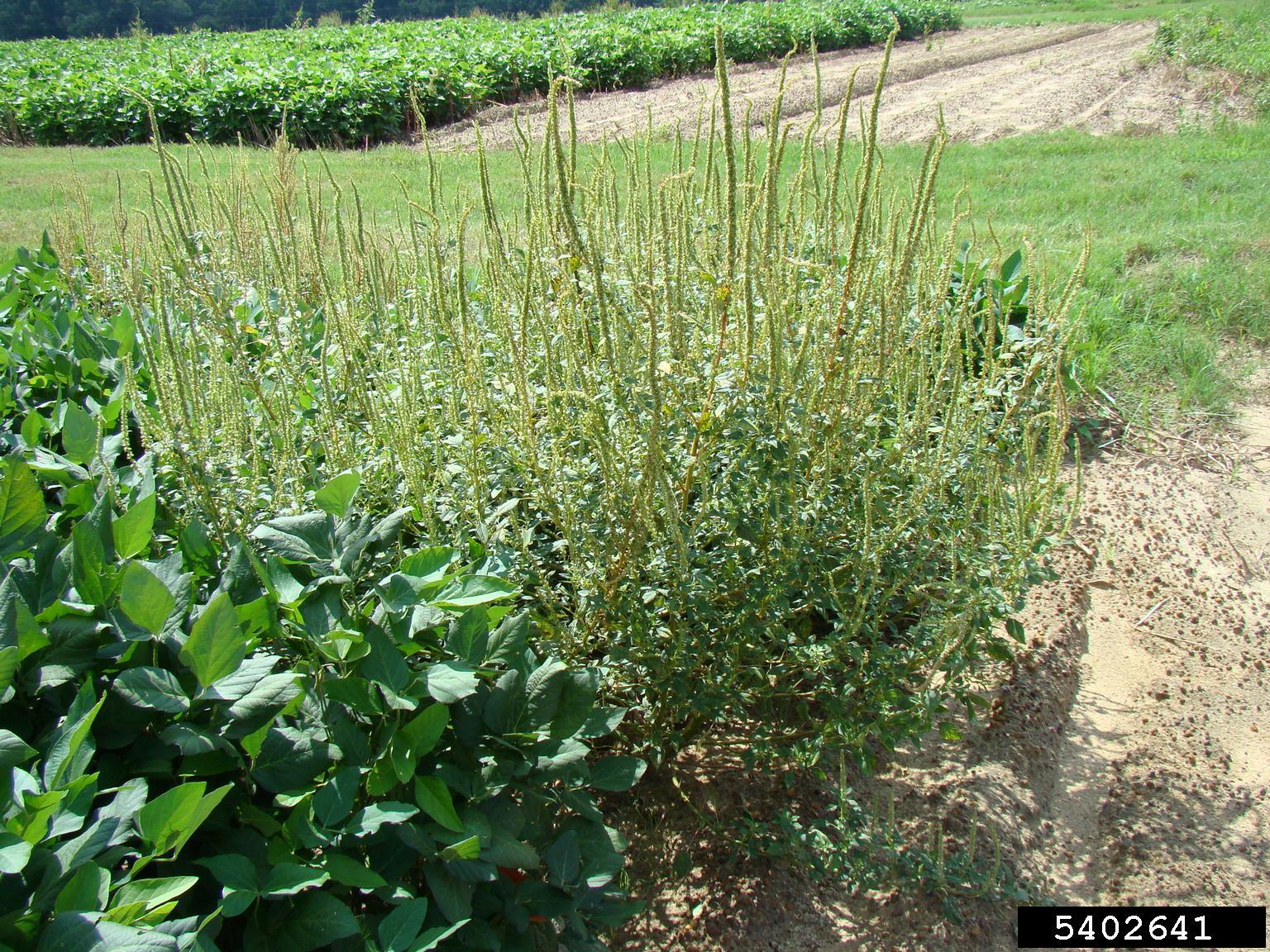
Palmer pigweed (tall plants, center) at the edge of a field of soybean (lower left). Photo by Rebekah D. Wallace, University of Georgia (Image 5402641, ForestryImages.org, Creative Commons Attribution-Noncommercial 3.0 United States license).
Herbicide-resistant GMO crops include varieties of maize and soybean, the two most widely grown crops in the U.S., as well as other plants. Most of the maize grown in the U.S. today is both Bt and herbicide resistant. In fact, by 2016, more than 78% of the genetically modified maize acreage in the world was devoted to maize engineered with both Bt and herbicide resistance.
Because widespread adoption of herbicide-resistant crops has caused the herbicide glyphosate to be used more widely, glyphosate has become less effective at killing weeds. This is simply selection in action. As the crops are sprayed, only weeds that have some resistance to the herbicide grow and survive to reproduce. Over multiple generations, as non-herbicide-resistant weeds are killed and herbicide-resistant weeds reproduce, the overall weed population will include a greater proportion of plants that are resistant to the herbicide.
Glyphosate resistance has already become a problem in the U.S., with some farmers now turning to dicamba-resistant crops. Dicamba is generally damaging to broad-leaved plants, including crops that have not been engineered for dicamba resistance and wild plants (even trees). It also has a tendency to vaporize and drift from fields where it has been applied during hot weather. As dicamba use has increased, so have complaints about damage to non-target plants, including crops.
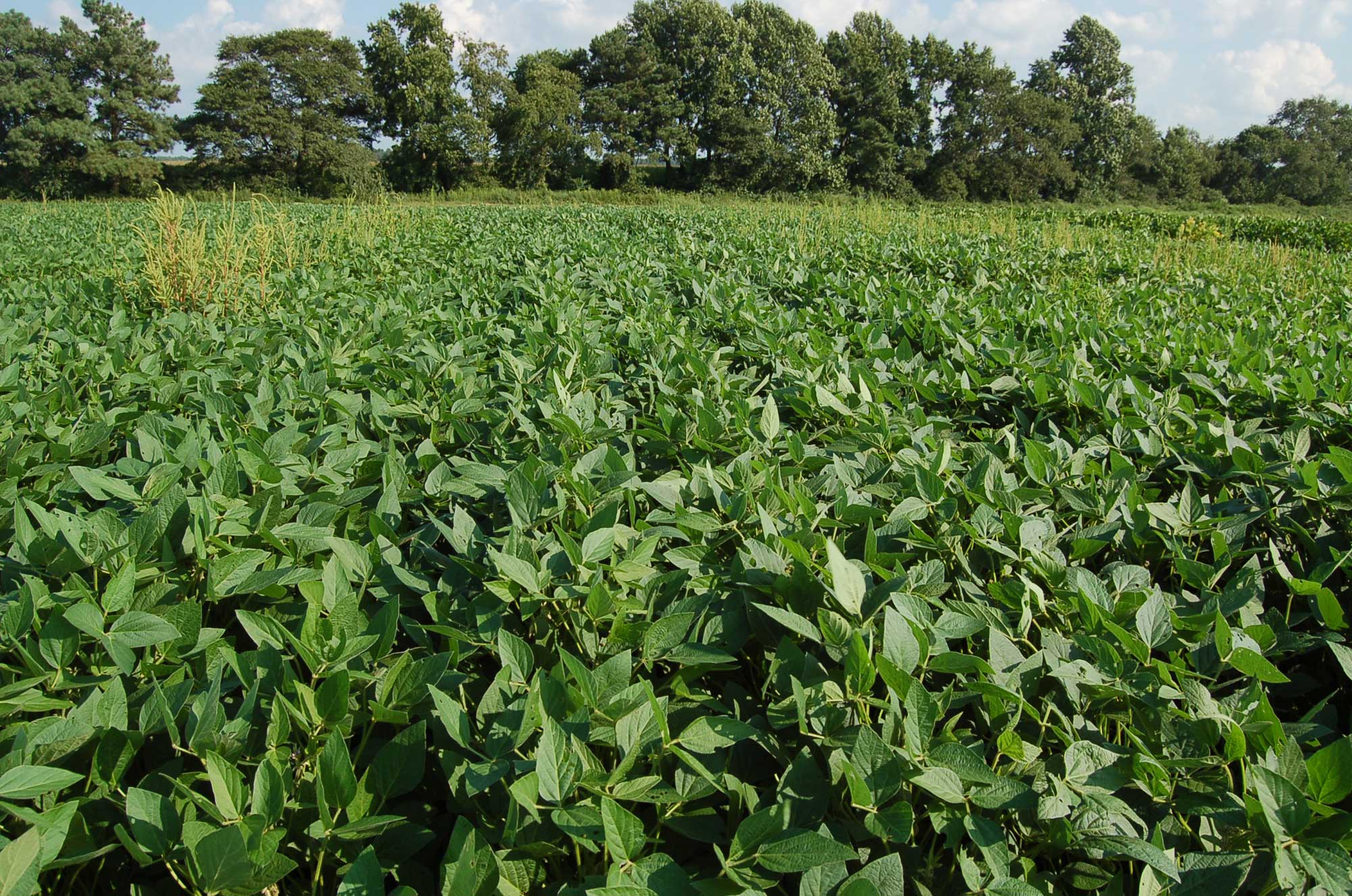
Palmer pigweed (tall plants) in a soybean test field. Photo by University of Delaware Carvel REC on flickr (Creative Commons Attribution 2.0 Generic license, image resized).
Resources
Websites
Agricultural biotechnology (U.S. Food and Drug Administration): https://www.fda.gov/food/consumers/agricultural-biotechnology
BE [Bioengineering] Disclosure (USDA Agricultural Marketing Service): https://www.ams.usda.gov/rules-regulations/be
European Corn Borer (University of Florida/IFAS Featured Creatures): https://entnemdept.ufl.edu/creatures/field/e_corn_borer.htm
Insect Resistance Management for Bt plant-incorporated protectants (U.S. Environmental Protection Agency): https://www.epa.gov/regulation-biotechnology-under-tsca-and-fifra/insect-resistance-management-bt-plant-incorporated
Relevance of Evolution: Agriculture (Understanding Evolution, University of California Berkeley Museum of Paleontology): https://evolution.berkeley.edu/the-relevance-of-evolution/agriculture/
Signal to Noise Special Edition: GMOs and our food (2015, Harvard University Graduate School of Arts and Sciences): https://sitn.hms.harvard.edu/signal-to-noise-special-edition-gmos-and-our-food/
Videos
Science IRL: GMOs! (YouTube): https://youtu.be/-b_Un-lGSWo
Articles and books
Brown, H. C. 2021. Attack of the superweeds. The New York Times, August 18, 2021. https://www.nytimes.com/2021/08/18/magazine/superweeds-monsanto.html
Elmore, B. 2022. The herbicide dicamba was supposed to solve farmers' weed problems - instead, it's making farming harder for many of them. The Conversation, January 26, 2022. https://theconversation.com/the-herbicide-dicamba-was-supposed-to-solve-farmers-weed-problems-instead-its-making-farming-harder-for-many-of-them-174181
Evert, R. F., and S. E. Eichhorn. 2013. Raven Biology of Plants, 8th ed. W.H. Freeman and Company Publishers, New York, New York.
Goldy, R. 2019. New label denoting bioengineered ingredients will soon appear on food items in 2020. Michigan State University Extension, December 4, 2019. https://www.canr.msu.edu/news/new-food-label-denoting-bioengineered-ingredients
Levetin, P., and D. S. McMahon. 2016. Plants and Society, 7th ed. McGraw Hill Education, New York.
Lipton, E. 2017. Crops in 25 states damaged by unintended drift of weed killer. The New York Times, November 1, 2017. https://www.nytimes.com/2017/11/01/business/soybeans-pesticide.html
Ogliore, T. 2020. Long-term analysis shows GM cotton no match for insects in India. Washington University in St. Louis Newsroom, March 13, 2020. https://source.wustl.edu/2020/03/long-term-analysis-shows-gm-cotton-no-match-for-insects-in-india/
Simpson, B.B., and M.C. Ogorzaly. 2001. Economic botany, plants in our world, 3rd ed. McGraw Hill Higher Education, New York, New York.
Weir, R. T., and J. J. Dalzell. 2020. Agrobacterium: Soil microbe, plant pathogen, and natural genetic engineer. Frontiers for Young Minds 8: 64. https://doi.org/10.3389/frym.2020.00064
Scientific (technical) articles, books, and repots
Abbas, M.S.T. 2018. Genetically engineered (modified) crops (Bacillus thuringiensis crops) and the world controversy on their safety. Egypt Journal of Biological Pest Control 28: 52. https://doi.org/10.1186/s41938-018-0051-2
Behrens, M. R., N. Mutlu, S. Chakroborty, R. Dumitru, W. Z. Jiang, B. J. Lavallee, P. L. Herman, T. E. Clements, and D. P. Weeks. 2007. Dicamba resistance: enlarging and preserving biotechnology-based weed management strategies. Science 316: 1185-1188. https://doi.org/10.1126/science.1141596
Bruns, H. A. 2017. Southern Corn Leaf Blight: A story worth retelling. Agronomy Journal 109: 1-7. https://doi.org/10.2134/agronj2017.01.0006
Funke, T., H. Han, M. L. Healy-Fried, M. Fischer, and E. Schönbrunn. 2006. Molecular basis for the herbicide resistance of Roundup Ready crops. Proceedings of the National Academy of Sciences, U.S.A. 103: 13010-13015. https://doi.org/10.1073/pnas.0603638103
Gonsalves, D., S. Tripathi, J. B. Carr, and J. Y. Suzuki. 2010. Papaya ringspot virus. The Plant Health Instructor. https://doi.org/10.1094/PHI-I-2010-1004-01
Tabashnik, B. E., T. Brévault, and Y. Carrière. 2013. Insect resistance to Bt crops: lessons from the first billion acres. Nature Biotechnology 31: 510-521. https://doi.org/10.1038/nbt.2597



